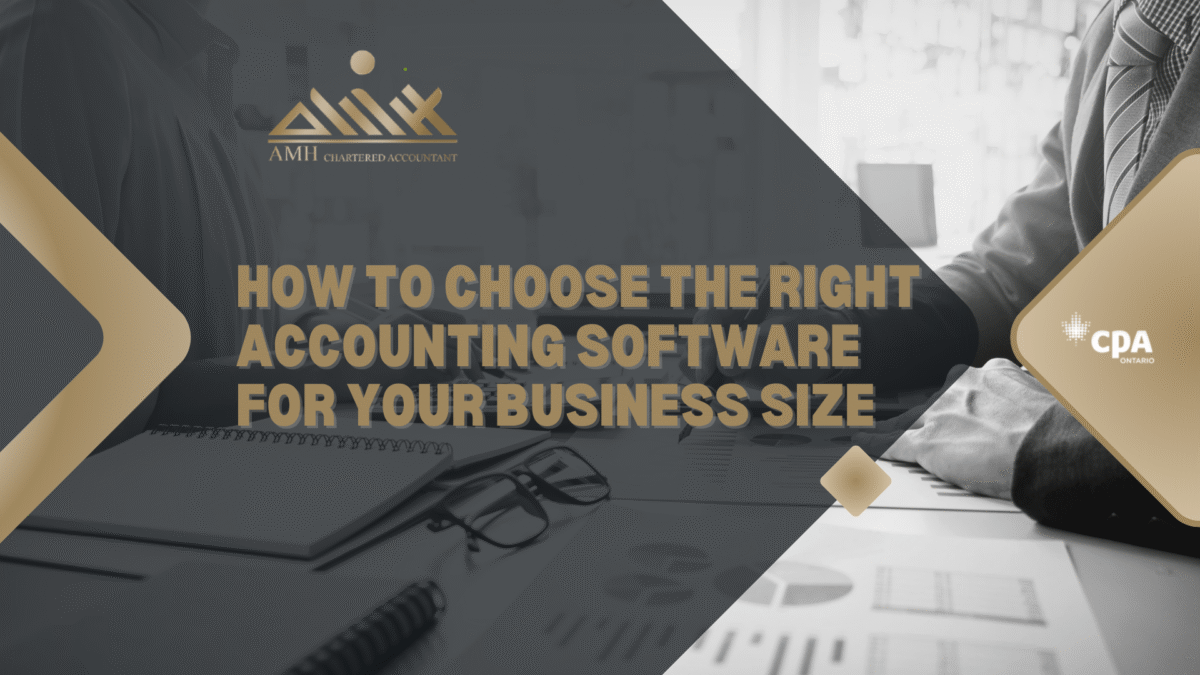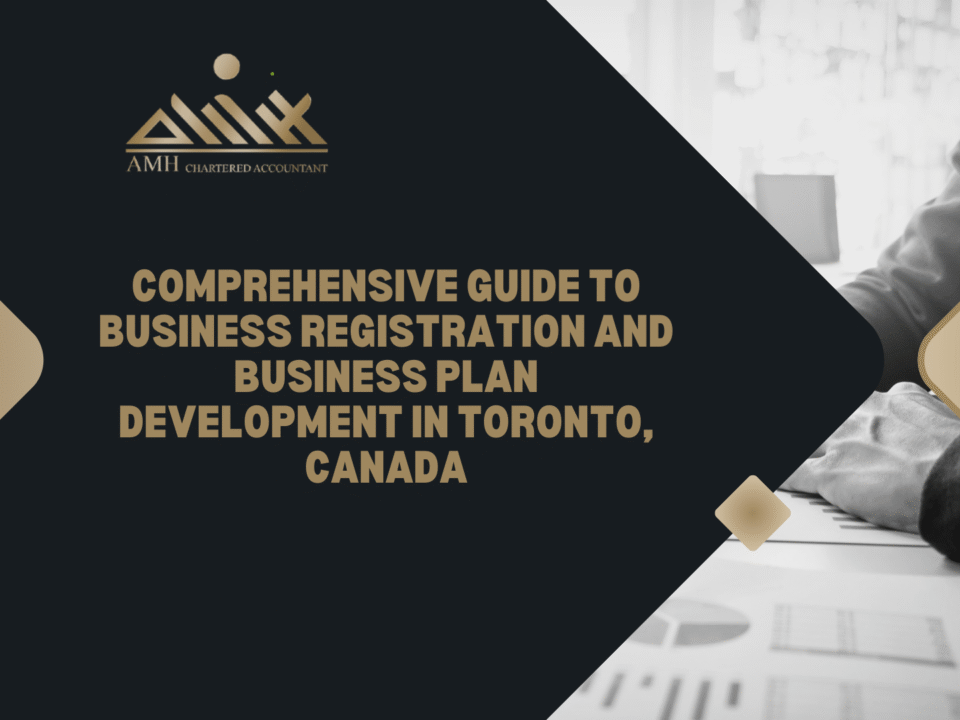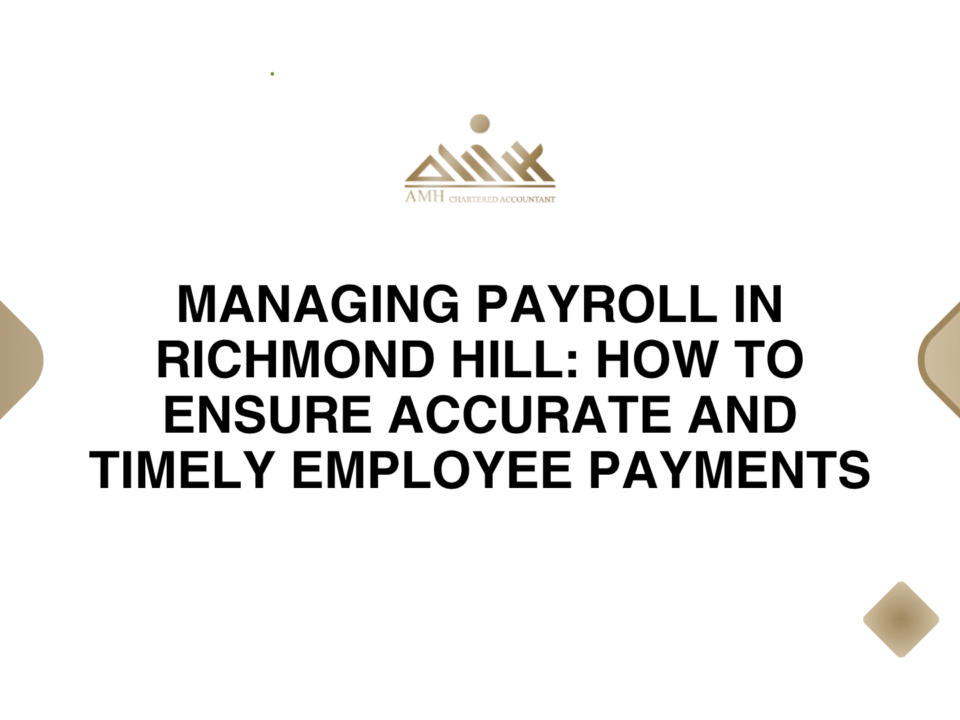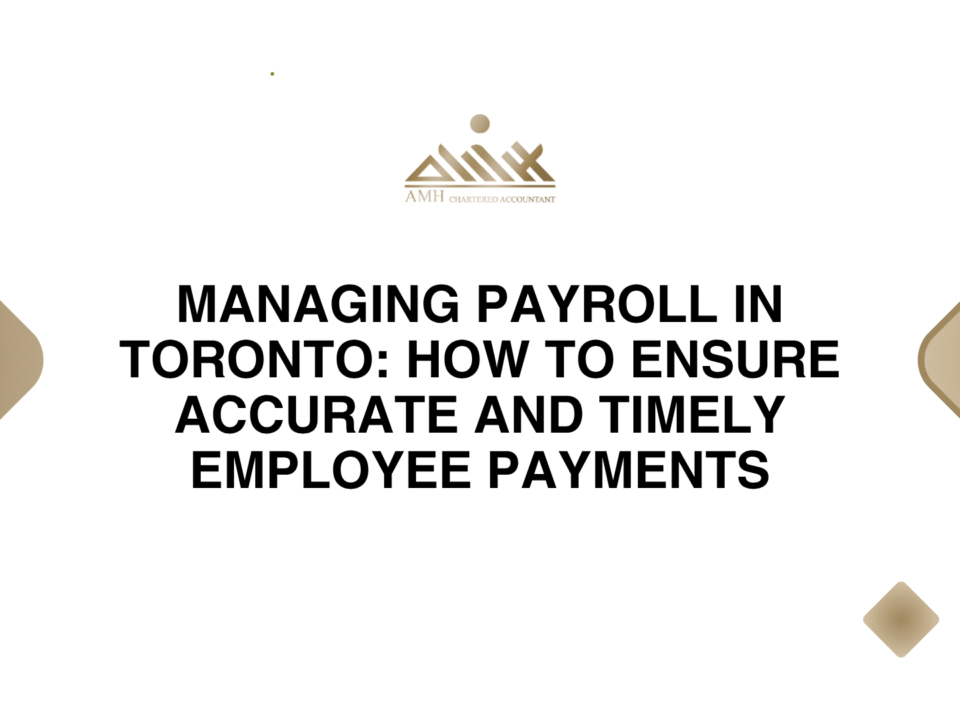
Accounting for R&D Projects: How to Maximize Tax Benefits
June 3, 2025
5 Key Financial Metrics Every Business Owner Should Track
June 10, 2025How to Choose the Right Accounting Software for Your Business Size
Discover how to select the ideal accounting software for your business size—from small startups to growing enterprises—with tailored guidance from AMH Chartered Professional Accountant.
Introduction
Choosing the right accounting software is critical to smooth operations, regulatory compliance, and sustainable growth. AMH Chartered Professional Accountant helps businesses across Toronto and the GTA—including Milton, Oakville, Hamilton, Kitchener, and Waterloo—select and implement software solutions that align with their size, needs, and financial goals. This guide walks you through evaluating, comparing, and implementing the right platform, with personalized support at every step.
Understand Your Business Size and Complexity
Accounting needs differ significantly depending on whether you’re a small startup, growing SME, or established medium enterprise. Consider:
Small Business / Startup (1–20 employees, below $1M revenue): Prioritize affordability, ease of use, and basic compliance.
Small-to-Medium (20–100 employees, $1–10M revenue): Need automation, payroll integration, reporting, and integration with operations.
Medium Enterprise (100+ staff, $10M+): Require ERP features—inventory control, multi‑currency, advanced reporting, and robust compliance tools. youtube.combizfund.ca
Define Core Features Based on Business Size
| Business Size | Key Software Features |
|---|---|
| Small / Startup | Invoicing, expense tracking, bank feeds, basic reporting, payroll integration |
| Small-to-Medium | Multi-user access, tax automation, timesheets, CRM/ERP integration |
| Medium Enterprise | ERP functionalities, inventory, multi‑location, international compliance, advanced analytics |
Best Accounting Software for Small Businesses (1–20 Employees)
Recommended Options:
QuickBooks Online – Widely used, full-featured, real-time reporting, payroll, invoicing ft.comtechnologyadvice.com+3rotessa.com+3bizfund.ca+3.
Xero – User-friendly, bank integrations in Canada, supports multiple currencies youtube.com+15rotessa.com+15bizfund.ca+15.
FreshBooks – Developed in Toronto; ideal for service-based firms, easy invoicing and time tracking groupeconseilera.com+11rotessa.com+11bizfund.ca+11.
Wave – Free core accounting featuring double-entry, bank sync, receipt scanning salaccounting.ca+4bizfund.ca+4bdc.ca+4.
Zoho Books – Scalable and cost-effective, offers automation and good multi-user features youtube.com+15bizfund.ca+15technologyadvice.com+15.
Why This Matters:
Small businesses need affordability and usability—Wave offers cost control, while QuickBooks Online and Xero give room to grow.
Top Tools for Small-to-Medium Businesses
Once you grow beyond the basics, your software should support:
Sage 50cloud – Desktop/cloud hybrid, inventory, payroll under Canadian regulations bdc.ca+12bizfund.ca+12groupeconseilera.com+12rotessa.com+2quickbooks.intuit.com+2technologyadvice.com+2.
Microsoft Dynamics 365 Business Central – An ERP-class system with advanced capabilities for scalability and integration tipalti.com.
NetSuite / Sage Intacct – Fully-featured ERP tools, ideal for revenue over $50M groupeconseilera.com+2tipalti.com+2techradar.com+2.
Evaluating Software: Five Key Criteria
Pricing vs Features: Balance your budget with must-have tools. Wave is free, Xero and QB start modestly, Sage and ERP are tiered higher.
Ease of Use: Software should feel intuitive. FreshBooks and Xero score high; ERP tools often need training.
Scalability: Think ahead. QuickBooks, Xero, Sage 50cloud, and Business Central offer migration paths as you grow.
Integrations: Connect with banks, e-commerce, CRM, payroll. Xero and QB excel at seamless integration bizfund.ca+1groupeconseilera.com+1.
Local Tax and Payroll: Ensure compliance with CRA, GST/HST, CPP/EI. Sage, Xero, Wave, and FreshBooks are designed for Canadian standards rotessa.com+3bizfund.ca+3groupeconseilera.com+3.
Step 1: Conduct a Needs Assessment
Assess your current and future accounting needs:
Number of users
Payroll involvement
Inventory or e‑commerce operations
Reporting and analytics expectations
AMH CPA performs this analysis, mapping your needs to software features.
Step 2: Create a Shortlist of Candidates
Based on your size and needs, we recommend:
Startup: QuickBooks Online, Xero, FreshBooks, or free Wave.
Growing SME: Sage 50cloud, QuickBooks, Xero.
Medium Enterprise: Microsoft Dynamics 365 Business Central or NetSuite.
Step 3: Trial, Demo, or Pilot
Always test. Most platforms offer free trials (e.g., QuickBooks, Xero, Sage). AMH arranges guided pilots for deeper insight and practical validation.
Step 4: Develop a Transition Plan
Implement in four phases:
Migration Planning – Port over chart of accounts, customer/vendor lists, historical data.
Setup & Configuration – Define permissions, bank integrations, tax, and payroll settings.
Training – Provide staff training and reference guides.
Go-Live & Support – Post-launch support, troubleshooting, and data flow verification.
AMH handles the end-to-end process, reducing risk and ensuring continuity.
Step 5: Use Ongoing Review Processes
Monitor KPIs like cash flow, margins, and accounts receivable.
Reconcile bank statements monthly.
Adapt settings as you grow.
Regular reviews, performed by AMH, help ensure compliance, accuracy, and system effectiveness.
Why Choose AMH Chartered Professional Accountant
Local Expertise: Deep experience with Canadian standards, GTA business dynamics, and CRA compliance.
Aligned Pricing: Competitive fees tailored to business size, from startups to mid-market entities.
Comprehensive Support: Cloud setup, migration, training, bookkeeping, payroll, tax planning, advisory—all under one roof.
Proven Track Record: Trusted partner for entrepreneurs in Milton, Oakville, Hamilton, Kitchener, and Waterloo.
Conclusion
Choosing the right accounting software is a strategic decision that influences efficiency, compliance, and scalability. By following these steps—needs assessment, shortlist, pilot, implementation planning, and ongoing review—you can select a system tailored to your business size and future growth. With AMH Chartered Professional Accountant, you’re not just choosing software; you’re gaining a trusted partner dedicated to setting your financial foundation right.
📞 Ready to explore your options? Contact us for a free consultation at (416) 900‑6079 or visit amhtaxes.com.
Frequently Asked Questions
Which software suits a startup with minimal budget?
Wave is fully free and ideal for micro-businesses. As you grow, consider QuickBooks or Xero.
Do I need payroll features from day one?
If hiring employees or contractors, yes—most software offers payroll add-ons. AMH helps set it up compliant with CRA regulations.
Can I switch platforms later?
Absolutely—all major platforms support data migration. We plan transitions to preserve historical data and minimize disruption.
What if I need inventory management?
Choose Sage 50cloud for light inventory; opt for Microsoft Dynamics 365 if you need complex or multi-location inventory control.
How important is bank integration?
Highly. Automatic bank feeds reduce manual errors and speed up reconciliations. QuickBooks and Xero offer strong Canadian bank integrations.
Does AMH offer training?
Yes. We provide hands-on training sessions, documentation, and ongoing support to ensure your team uses the software effectively.
Partnering with the right accounting software and advisor equips your business for solid financial performance and growth. Whenever you’re ready, AMH CPA is here to guide you through selecting, implementing, and optimizing your accounting system—tailored to your unique business size and goals.




